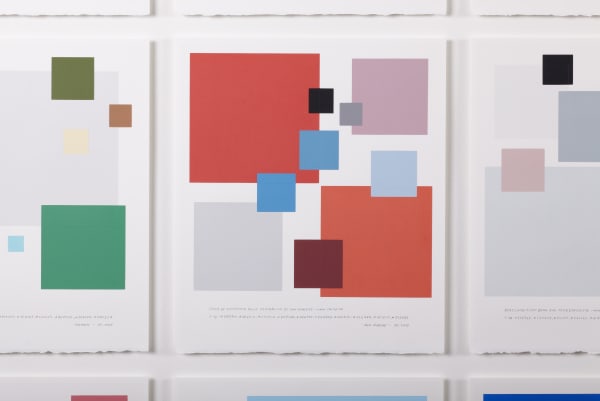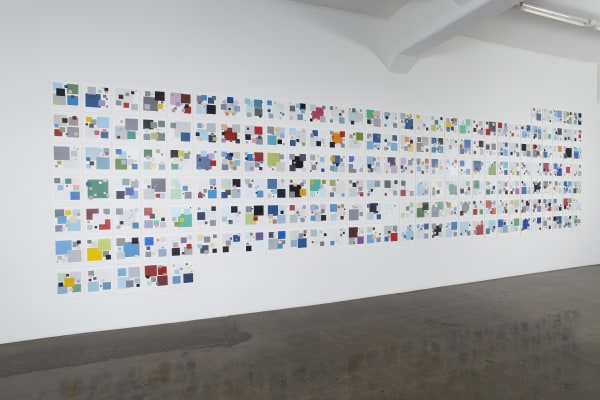Colour Codes: Sara Hughes
Sara Hughes exhibition Colour codes brings together a series of new paintings and works on paper that continue her exploration of colour relationships in her distinctively hypnotic compositions of colour and form. Drawn from her in depth analysis of the colour content of websites, Colour codes focuses particularly on the way in which colour is used by financial institutions online and extends Hughes ongoing interest in global systems of information exchange.
Writer Christina Végh noted in a recent essay that colour, form and composition - classic issues of painting - dominate Hughes work, which often takes the form of site-specific installations. The three factors are linked to themes familiar to each and every one of us in todays world: world-wide systems with a constantly increasing influence on everyday life, like computer viruses, fast-food chains, alliances between nations and their symbolic representation, the financial system with its ever-changing values, and more generally diverse types of statistics. Their considerable media presence enables the latter to convey the idea of measuring various conditions in the world. The fact that she manages to focus on painterly means despite the great complexity of her thematic starting points highlights the quality of Hughes work. (Contemporary Echo Chamber, 2009)
In an artist statement Hughes explains: I have an ongoing concern with the complexity of colour and relationships between colour in art and colour in everyday life. The exhibition Colour codes focuses on ways colour is used on the internet and specifically investigates how financial institutions create an interface of image and information via colour on their websites. In my recent exhibitions I have been investigating the language of diagrams and data graphics in relation to economic and social data and this has led to an examination of the way financial institutions present themselves in colour and the colour codes they use. To create a high degree of accuracy to this research I have worked with a specialist British web consultant who has customized a program for my project that allows me to accurately analyze the proportion of colour data on web pages.
Contemporary knowledge of colour has become very screen focused and I am interested in the way that colour influences, manipulates and affects our understanding of web browsing. Within this context I have identified the largest commercial bank (by assets) in every country and taken the ten predominant colours of each of these websites to create a pallet of 1950 paint colours for this exhibition. I have mixed each colour so that its pigmentation matches its hexadecimal value as closely as possible. Each online colour exists as a six-digit code created from a combination of letters and numbers that refer to the red, green and blue components of the colour, these codes are interpreted by HTML allowing for more than sixteen million colours to be created for online visualization. This method of colour matching has highlighted to me the contrast between the additive process of mixing light and the subtractive process of mixing paint and emphasised the differences of seeing colour on screen or in a painting.
The exhibition draws on historical aspects of colour and I make use of devices from abstractions historical framework, with particular reference to Josef Albers. Yet it is my aim to position the content of the work in relation to contemporary interactions of colour - presenting a global over view of colour in relation to the financial institutions that influence the world and the current economic situation. I approach the paintings as schemas for thinking - they can be seen as gauges influenced by art, design, taste, advertising, politics and power. The work oscillates between visual image and visual information and is driven by my desire to articulate social meaning by utilizing aspects of perception and semiology.
Sara Hughes is a dynamic painter with a career well established and highly regarded in Australasia. Hughes has exhibited in major public galleries in New Zealand and her paintings and installations are held in many important Australasian public and private collections including the Chartwell Collection; Auckland City Art Gallery Toi o Tāmaki; Te Papa Tongarewa; Wellington and the National Gallery of Australia, Canberra. Her work has attracted significant attention winning both the Wallace Art Award and the Norsewear Art Award in 2005. In 2008 she was the first New Zealand recipient of The RIPE: Art and Australia magazine Art Award and she has been selected to participate in a number of notable residencies including the Francis Hodgkins Fellowship in 2003, the International Studio and Curatorial Program in New York in 2007 and the Creative New Zealand Berlin Visual Artists Residency at the Knstlerhaus Bethanien in 2008/09.
Her work has been published widely appearing in international art and architecture magazines including Art in America, Artlink, and Monument. She is included in Warrick Brown and Liz Caughey's recent anthologies on New Zealand art and she is the featured artist in the current Spring edition of Art New Zealand.












